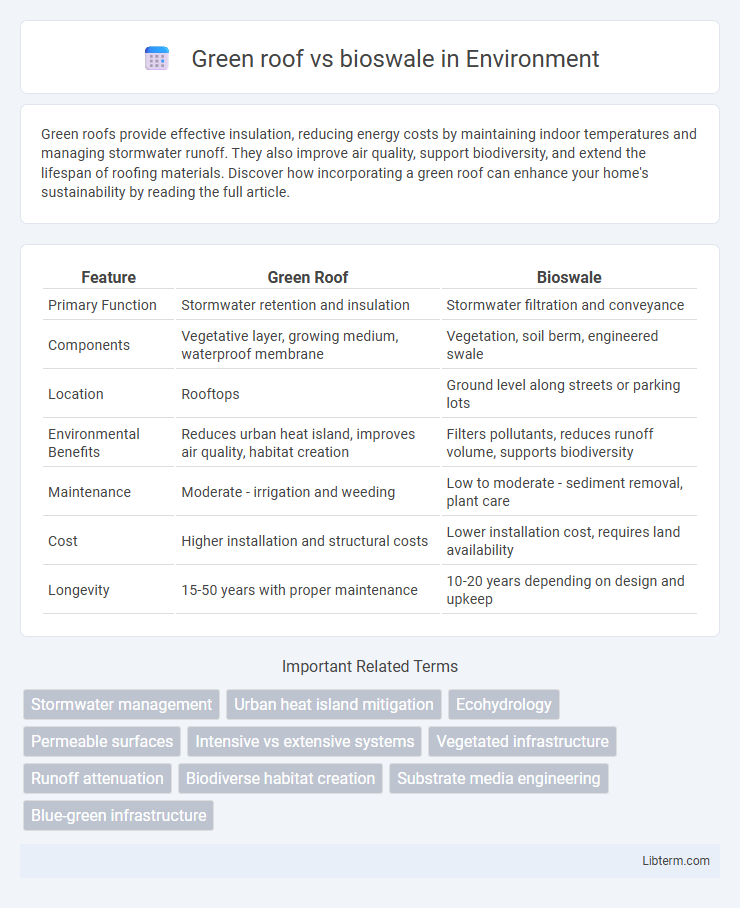Green roofs provide effective insulation, reducing energy costs by maintaining indoor temperatures and managing stormwater runoff. They also improve air quality, support biodiversity, and extend the lifespan of roofing materials. Discover how incorporating a green roof can enhance your home's sustainability by reading the full article.
Table of Comparison
| Feature | Green Roof | Bioswale |
|---|---|---|
| Primary Function | Stormwater retention and insulation | Stormwater filtration and conveyance |
| Components | Vegetative layer, growing medium, waterproof membrane | Vegetation, soil berm, engineered swale |
| Location | Rooftops | Ground level along streets or parking lots |
| Environmental Benefits | Reduces urban heat island, improves air quality, habitat creation | Filters pollutants, reduces runoff volume, supports biodiversity |
| Maintenance | Moderate - irrigation and weeding | Low to moderate - sediment removal, plant care |
| Cost | Higher installation and structural costs | Lower installation cost, requires land availability |
| Longevity | 15-50 years with proper maintenance | 10-20 years depending on design and upkeep |
Introduction to Green Roofs and Bioswales
Green roofs and bioswales are sustainable infrastructure solutions designed to manage stormwater and enhance urban ecosystems. Green roofs consist of vegetated layers on rooftops that reduce runoff, improve insulation, and promote biodiversity. Bioswales are landscape elements engineered to concentrate and convey stormwater runoff while filtering pollutants through soil and vegetation.
Core Principles: How Green Roofs and Bioswales Work
Green roofs function by layering vegetation over a waterproof membrane, enhancing stormwater retention through soil absorption and evapotranspiration, which reduces runoff and urban heat island effects. Bioswales utilize engineered, vegetated channels designed to capture, convey, and infiltrate stormwater, promoting filtration and pollutant removal while managing effective drainage. Both systems integrate natural processes to improve urban water management, emphasizing absorption, filtration, and sustainable runoff control.
Environmental Benefits of Green Roofs
Green roofs significantly reduce urban heat island effects by providing natural insulation and increasing evapotranspiration, which lowers ambient temperatures. They enhance air quality by filtering airborne pollutants and capturing carbon dioxide, contributing to improved urban ecosystems. Furthermore, green roofs manage stormwater by absorbing rainfall, thereby reducing runoff, mitigating flooding, and decreasing the burden on municipal drainage systems.
Environmental Benefits of Bioswales
Bioswales provide significant environmental benefits by effectively managing stormwater runoff, filtering pollutants, and reducing urban flooding through their engineered soil and vegetation layers. They enhance groundwater recharge and improve water quality by trapping sediments, heavy metals, and nutrients before water enters waterways. Unlike green roofs, bioswales contribute directly to erosion control and habitat creation at ground level, promoting biodiversity in urban landscapes.
Stormwater Management Comparison
Green roofs and bioswales both enhance stormwater management by reducing runoff volume and improving water quality, but they operate differently; green roofs capture and retain rainfall on building rooftops, promoting evapotranspiration, while bioswales channel and infiltrate stormwater at ground level through vegetated swales. Green roofs typically reduce peak flow rates by retaining 50-75% of rainfall, which decreases demand on urban drainage systems, whereas bioswales effectively filter pollutants and facilitate groundwater recharge by directing runoff through engineered soil media. In urban planning, combining green roofs with bioswales maximizes stormwater mitigation by leveraging rooftop retention and ground-level infiltration, contributing to resilient, sustainable water management systems.
Installation and Maintenance Requirements
Green roof installation requires specialized structural support and waterproofing layers to handle additional weight and prevent leaks, often involving professional design and construction teams. Bioswale installation includes grading, soil preparation, and planting native vegetation to facilitate stormwater filtration, with less structural modification but requires careful hydrological assessment. Maintenance for green roofs involves periodic irrigation, vegetation pruning, and inspection for membrane integrity, while bioswales need regular sediment removal, plant management, and erosion control to ensure effective water absorption and filtration.
Cost Analysis: Green Roof vs. Bioswale
Green roofs typically have higher initial installation costs, ranging from $10 to $25 per square foot, due to materials, structural support, and waterproofing requirements, while bioswales generally cost between $6 and $12 per square foot, reflecting simpler design and earthwork expenses. Maintenance expenses for green roofs average $0.75 to $1.50 per square foot annually, including irrigation and plant care, whereas bioswales require less frequent and less intensive upkeep, costing approximately $0.30 to $0.60 per square foot per year. Long-term cost savings from energy reduction with green roofs can partially offset higher upfront investments, while bioswales offer cost-effective stormwater management with minimal operational costs.
Urban Aesthetics and Usability
Green roofs enhance urban aesthetics by introducing vibrant vegetation atop buildings, creating visually appealing green spaces that improve air quality and reduce urban heat island effects. Bioswales, integrated into streetscapes or parks, offer functional stormwater management while contributing naturalistic landscape elements that promote biodiversity and pedestrian engagement. Both solutions increase urban usability by transforming underutilized spaces into ecological and recreational assets.
Suitability for Different Spaces
Green roofs are ideal for urban areas with limited ground space, providing insulation and stormwater management by covering building rooftops with vegetation. Bioswales are better suited for larger, open spaces like parking lots or road medians where they can effectively channel and filter runoff through gently sloped, vegetated swales. Both systems enhance sustainability, but green roofs maximize vertical space use while bioswales require horizontal land area for optimal function.
Choosing the Best Solution: Green Roof or Bioswale
Choosing the best solution between a green roof and a bioswale depends on the specific site conditions and project goals. Green roofs are ideal for urban buildings requiring rooftop stormwater management, heat reduction, and improved air quality, while bioswales excel in ground-level applications where managing runoff, filtering pollutants, and enhancing groundwater recharge are priorities. Assessing space availability, stormwater volume, maintenance capacity, and desired environmental benefits ensures effective and sustainable implementation of either green infrastructure system.
Green roof Infographic

 libterm.com
libterm.com